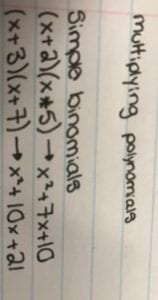In this week we learned about linear relations and how to use them in a t-chart. You can be given a set of numbers such as 4,8,12. We learned to start by establishing to say start at 4 increase by 4 each time. You put these numbers into a t-chart divided into X and Y, the numbers you are given eg; 4,8,12 go in the Y column. In the X column you labell it 1,2,3. To find the rule you start by figuring out the change in the numbers in the Y column, in this case they increase by 4. If we multiply 1,2,3 by 4 we get the numbers in the Y column.
Tag Archives: burtonmath10
math 10 – week 6
This week we continued multiplying polynomials. We were shown simple binomials and shortcuts we could take. Take an equation such as (x+2)(x+5) first of all we know x multiplied by x is x2 ( x squared) next we can add 5+2 to get 7, so far we have, x2+7. Next we can multiply 5×2 for 10 which finishes the equation. Therefore we get x2+7+10.
math 10 – week 5
This week in math I learned about area models. I really liked area models because I found them the simplest and gave me the right answer. With an area table you take an equation with two terms and create a 2×2 box, you take each part of the equation for a side and put a term above each box. Then you fill the box in like a multiplication table. Next you combine any like terms and write your simplified equation. The area model helped me as it was visual and very organized, this helped me to see what I was doing and feel more confident in my answer. 
 Loading...
Loading...
math 10- week 4
This week in math we continued trigonometry, we practiced sin,tan,cos -1. When using the sin/tan/cos -1 you are given a triangle with two side lengths. Such as this triangle we are given 16.2 and 29.3. The first thing I did was label the H, O, and A. The two side lengths given were the adjacent side and the opposite so it is tan -1. The equation would be solved by having 29.3/16.2 due to SOH CAH TOA, 29.3/16.2=1.8, now we can multiply 1.8 by tan-1 on our calculator and find out the angle we are looking for is 61 degrees.
week 3-math 10
this past week in math I learned about triangles and an introduction into trigonometry. The part I liked the best was, learning shortcuts to finding how many degrees each angle was. So far all the triangles we have used in our questions and examples have had one right angle being 90 degrees. Usually we were also given the reference angle. The shortcuts we learned about were that each triangle has a small medium and large angle, and that all the angles added together should be 180 degrees, if you are given a 90 degree angle you will just have to subtract your reference angle from the 90 degrees left. No measuring with a protractor needed.

